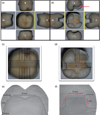1. Nguyen JF, Migonney V, Ruse ND, Sadoun M. Resin composite blocks via high-pressure high-temperature polymerization. Dent Mater. 2012; 28:529–534.

2. Stawarczyk B, Sener B, Trottmann A, Roos M, Ozcan M, Hämmerle CH. Discoloration of manually fabricated resins and industrially fabricated CAD/CAM blocks versus glass-ceramic: effect of storage media, duration,and subsequent polishing. Dent Mater J. 2012; 31:377–383.

3. Lauvahutanon S, Takahashi H, Shiozawa M, Iwasaki N, Asakawa Y, Oki M, Finger WJ, Arksornnukit M. Mechanical properties of composite resin blocks for CAD/CAM. Dent Mater J. 2014; 33:705–710.

4. Rocca GT, Bonnafous F, Rizcalla N, Krejci I. A technique to improve the esthetic aspects of CAD/CAM composite resin restorations. J Prosthet Dent. 2010; 104:273–275.

6. Molin M, Karlsson S. The fit of gold inlays and three ceramic inlay systems. A clinical and
in vitro study. Acta Odontol Scand. 1993; 51:201–206.

7. Wang WC, McDonald A, Petrie A, Setchell D. Interface dimensions of CEREC-3 MOD onlays. Eur J Prosthodont Restor Dent. 2007; 15:183–189.
8. Martin N, Jedynakiewicz NM. Interface dimensions of CEREC-2 MOD inlays. Dent Mater. 2000; 16:68–74.

9. Sjögren G. Marginal and internal fit of four different types of ceramic inlays after luting. An
in vitro study. Acta Odontol Scand. 1995; 53:24–28.

10. Reich S, Gozdowski S, Trentzsch L, Frankenberger R, Lohbauer U. Marginal fit of heat-pressed vs. CAD/CAM processed all-ceramic onlays using a milling unit prototype. Oper Dent. 2008; 33:644–650.

11. Baig MR, Tan KB, Nicholls JI. Evaluation of the marginal fit of a zirconia ceramic computer-aided machined (CAM) crown system. J Prosthet Dent. 2010; 104:216–227.

12. Boitelle P, Mawussi B, Tapie L, Fromentin O. A systematic review of CAD/CAM fit restoration evaluations. J Oral Rehabil. 2014; 41:853–874.

13. Nakamura T, Dei N, Kojima T, Wakabayashi K. Marginal and internal fit of Cerec 3 CAD/CAM all-ceramic crowns. Int J Prosthodont. 2003; 16:244–248.
14. Krasanaki ME, Pelekanos S, Andreiotelli M, Koutayas SO, Eliades G. X-ray microtomographic evaluation of the influence of two preparation types on marginal fit of CAD/CAM alumina copings: a pilot study. Int J Prosthodont. 2012; 25:170–172.
15. Pelekanos S, Koumanou M, Koutayas SO, Zinelis S, Eliades G. Micro-CT evaluation of the marginal fit of different In-Ceram alumina copings. Eur J Esthet Dent. 2009; 4:278–292.
16. Rungruanganunt P, Kelly JR, Adams DJ. Two imaging techniques for 3D quantification of pre-cementation space for CAD/CAM crowns. J Dent. 2010; 38:995–1000.

17. Matta RE, Schmitt J, Wichmann M, Holst S. Circumferential fit assessment of CAD/CAM single crowns-a pilot investigation on a new virtual analytical protocol. Quintessence Int. 2012; 43:801–809.
18. Fonseca JC, Henriques GE, Sobrinho LC, de Góes MF. Stress-relieving and porcelain firing cycle influence on marginal fit of commercially pure titanium and titanium-aluminum-vanadium copings. Dent Mater. 2003; 19:686–691.

19. Weaver JD, Johnson GH, Bales DJ. Marginal adaptation of castable ceramic crowns. J Prosthet Dent. 1991; 66:747–753.

20. McLean JW, von Fraunhofer JA. The estimation of cement film thickness by an
in vivo technique. Br Dent J. 1971; 131:107–111.

21. Brunthaler A, König F, Lucas T, Sperr W, Schedle A. Longevity of direct resin composite restorations in posterior teeth. Clin Oral Investig. 2003; 7:63–70.
22. Yu H, Wegehaupt FJ, Wiegand A, Roos M, Attin T, Buchalla W. Erosion and abrasion of tooth-colored restorative materials and human enamel. J Dent. 2009; 37:913–922.

23. Stawarczyk B, Egli R, Roos M, Ozcan M, Hämmerle CH. The impact of
in vitro aging on the mechanical and optical properties of indirect veneering composite resins. J Prosthet Dent. 2011; 106:386–398.

24. Tsitrou EA, Northeast SE, van Noort R. Evaluation of the marginal fit of three margin designs of resin composite crowns using CAD/CAM. J Dent. 2007; 35:68–73.

25. Akbar JH, Petrie CS, Walker MP, Williams K, Eick JD. Marginal adaptation of Cerec 3 CAD/CAM composite crowns using two different finish line preparation designs. J Prosthodont. 2006; 15:155–163.

26. Kim JH, Cho BH, Lee JH, Kwon SJ, Yi YA, Shin Y, Roh BD, Seo DG. Influence of preparation design on fit and ceramic thickness of CEREC 3 partial ceramic crowns after cementation. Acta Odontol Scand. 2015; 73:107–113.

27. Seo D, Yi Y, Roh B. The effect of preparation designs on the marginal and internal gaps in Cerec3 partial ceramic crowns. J Dent. 2009; 37:374–382.

28. Nam SJ, Yoon MJ, Kim WH, Ryu GJ, Bang MK, Huh JB. Marginal and Internal Fit of Conventional Metal-Ceramic and Lithium Disilicate CAD/CAM Crowns. Int J Prosthodont. 2015; 28:519–521.








 PDF
PDF ePub
ePub Citation
Citation Print
Print



 XML Download
XML Download